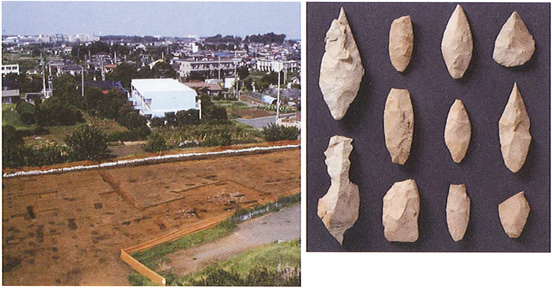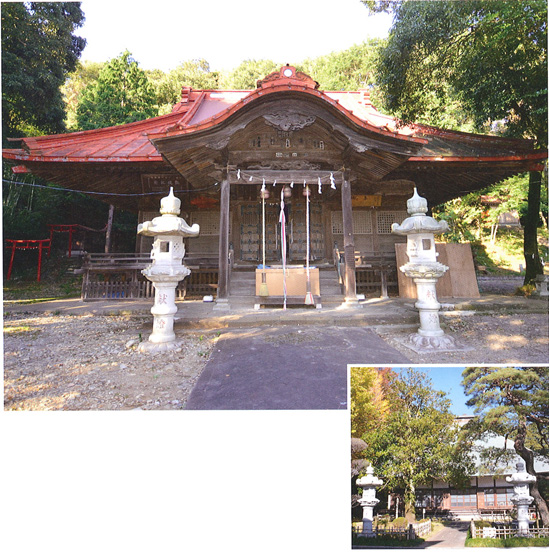| 狭山丘陵の麓には、旧石器時代から人びとが生活をしていました。 狭山池周辺の松原遺跡や狭山遺跡、浅間谷の浅間谷遺跡では、約2万年前の石槍などが発見されています。 | People have lived at the foot of the Sayama Hills since Paleolithic times. Stone spear tips and other ancient objects from around 20,000 years ago have been discovered at the Matsubara and Sayama prehistoric sites near Sayama Pond and at the Sengenyatsu prehistoric site in Sengendani. |
| 地形的・自然環境的に良好な瑞穂町周辺には、先人の営みがあった | Humans Have Inhabited Mizuho Since Primeval Times Thanks to the Area's Good Natural Features and Conditions |
| 瑞穂町では狭山池東岸の狭山遺跡で約5000年前と推定される竪穴式住居が発見され、当時の人が使った土器や石器も出土しています。また、狭山丘陵の六道山遺跡では、石鏃など多数の石器と、狩猟用の陥し穴が発見されています。この辺りは食料や飲み水が得やすく、古代から居住に適した場所だったのでしょう。 | Pit dwellings estimated to be around 5,000 years old were discovered at the Sayama prehistoric site on the east bank of Sayama Pond in Mizuho, and stone and earthen implements used by the people of that time have been unearthed. Numerous stone arrowheads and other stone implements, as well as hidden pitfalls for hunting, have also been discovered at the Rokudoyama prehistoric site in the Sayama Hills. This area was probably well suited for habitation from ancient times because food and drinking water were easily obtainable. |
| 稲作が伝わり、弥生文化が成立したころの明確な集落跡は発見されていませんが、弥生時代を経て古墳時代へと集落が栄えていったことを示す遺跡もあります。加藤塚や石畑地区の神明神社境内には、かつて塚状の盛土があったといわれています。 | No clear signs of settlements from around the time that rice cultivation was introduced and the culture of the Yayoi period was formed (from around the fourth century BC to the third century AD) have been discovered. However, there are sites that indicate that settlements flourished from the Yayoi period to the Kofun period (from the late third to the seventh century). It is said that there were once mound-shaped embankments within Shinmei Temple's grounds in Ishihata as well as around Kato Shrine. |
| 古代の武蔵国には、現在の府中市に武蔵国府がありました。その頃、狭山丘陵の南麓には谷津田がつくられ、集落が発達していたようです。延喜5(927)年に完成した延喜式の神明帳には、多摩八座の一つとして「阿豆佐味天神社」の名が記されています。中世の武蔵国は、武蔵七党と呼ばれる武士団が活躍する時代でした。この時代には、瑞穂町を代表する古刹・福正寺が建立されています。鎌倉時代から戦国時代にかけ、死者の供養のための板碑の建造が盛んになりました。町内では70基余りが発見されています。 | In ancient times, the capital of Musashi Province was located in today's Fuchu. Rice paddies were created in the bottoms of the valleys in the southern foothills of the Sayama Hills then, and settlements apparently formed there. Azusamiten Shrine was mentioned as one of the Tama region's eight traditional shrines in the official government shrine list completed in AD 927, the fifth year of the Encho period (923-31). The middle ages were a time in which bands of warriors known as the "seven clans of the Musashi" were active in Musashi Province. It was during this period that Mizuho's venerable temple, Fukushoji temple, was built. Construction of stone memorials for the repose of the dead flourished from the Kamakura period (1185-1333) through the Sengoku (Warring States) period (the middle of the fifteenth century to the beginning of the seventeenth century). Around 70 of these have been discovered within the town limits. |
 | 松原遺跡 旧石器時代 石器集中区全景 Matsubara prehistoric site Paleolithic period Panoramic view of the area where stone implements were concentrated |

